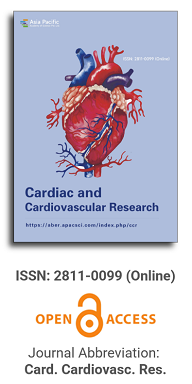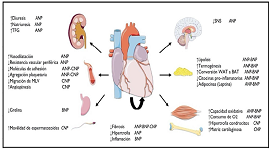
Asia Pacific Academy of Science Pte. Ltd. (APACSCI) specializes in international journal publishing. APACSCI adopts the open access publishing model and provides an important communication bridge for academic groups whose interest fields include engineering, technology, medicine, computer, mathematics, agriculture and forestry, and environment.

Comparison of different thromboembolism risk scores with the predictive value of left atrial thrombosis and/or spontaneous ultrasound in patients with non-valvular atrial fibrillation
Vol 2, Issue 2, 2021
Download PDF
Abstract
Objective: To compare the predictive value of CHADS2, CHA2DS2-VASc, ATRIA and R2-CHADS2 scores and left atrial thrombosis and/or spontaneous ultrasound in patients with non-valvular atrial fibrillation (AF) Methods patients with non-valvular atrial fibrillation who were hospitalized in the Department of Cardiology of Sun Yat Sen Memorial. Results: 564 patients were included. The age of patients was (61.1 ± 10.1) years old, of which 63.3% were men. Hypertension was the most common complication, which was found in 49.6% of patients. Patients were divided into thrombus group (n = 82) and non-thrombus group (n = 482) according to the presence of left atrial thrombus and/or spontaneous ultrasound development CHADS2 score in thrombotic group (1[0,2]) was higher than that in non-thrombotic group (1[0,1]) (P < 0.05), and CHA2DS2-VASc score in thrombotic group (2[1,3]) was higher than that in non-thrombotic group (2[1,2]) (P < 0.05) 11.06%, 13.39%, 26.58%, 18.52% and 16.67% of patients with CHADS2 score of 0, 1, 2, 3 and 4 had left atrial thrombus and/or spontaneous ultrasound (P fortrend = 0.016), and 11.06%, 13.39% and 23.68% of patients with low, medium and high risk had left atrial thrombus and/or spontaneous ultrasound (P fortrend = 0.004); 10.81%, 10.19%, 16.57%, 21.05%, 21.05%, 16.67%, 14.29% of patients with CHA2DS2-VASc score of 0, 1, 2, 3, 4, 5, 6 or above had left atrial thrombosis and/or spontaneous ultrasound development (P fortrend = 0.019), and 8.75%, 13.90% and 19.35% of patients with low, medium and high risk had left atrial thrombosis and/or spontaneous ultrasound development (P fortrend = 0.004); The area under the ROC curve of ATRIA score and R2-CHADS2 score was 0.562. The samples based on this study had no statistical significance in the diagnosis of left atrial thrombosis and/or spontaneous ultrasound (P > 0.05). Conclusion: CHADS2 score and CHA2DS2-VASc score have considerable and limited diagnostic value for left atrial thrombosis and/or spontaneous ultrasound in patients with non-valvular atrial fibrillation.
Keywords
References
- Minno MN, Ambrosino P, DelloRusso A, et al. Prevalence of left atrial thrombus in patients with non-valvular atrial fibrillation. Thrombosis and Haemostasis. 2016; 115(03): 663-677. doi: 10.1160/th15-07-0532
- Lowe BS, Kusunose K, Motoki I, et al. Prognostic Significance of Left Atrial Appendage “Sludge” in Patients with Atrial Fibrillation: A New Transesophageal Echocardiographic Thromboembolic Risk Factor. Journal of the American Society of Echocardiography. 2014; 27(11): 1176-1183. doi: 10.1016/j.echo.2014.08.016
- Bernhardt P, Schmidt H, Hammerstingl C, et al. Patients with Atrial Fibrillation and Dense Spontaneous Echo Contrast at High Risk. Journal of the American College of Cardiology. 2005; 45(11): 1807-1812. doi: 10.1016/j.jacc.2004.11.071
- Kim YG, Shim J, Oh SK, et al. Risk Factors for Ischemic Stroke in Atrial Fibrillation Patients Undergoing Radiof-requency Catheter Ablation. Scientific Reports. 2019; 9(1). doi: 10.1038/s41598-019-43566-z
- Fatkin D, Kelly R, Feneley M. Relations between left atrial appendage blood flow velocity, spontaneous echocar-diographic contrast and thromboembolic risk in vivo. J Am Coll Cardiol. 1994; 23(4): 961.
- Gage BF, Waterman AD, Shannon W, et al. Validation of Clinical Classification Schemes for Predicting Stroke. JAMA. 2001; 285(22): 2864. doi: 10.1001/jama.285.22.2864
- Lip GYH, Nieuwlaat R, Pisters R, et al. Refining Clinical Risk Stratification for Predicting Stroke and Thrombo-embolism in Atrial Fibrillation Using a Novel Risk Factor-Based Approach. Chest. 2010; 137(2): 263-272. doi: 10.1378/chest.09-1584
- Piccini JP, Stevens SR, Chang Y, et al. Renal Dysfunction as a Predictor of Stroke and Systemic Embolism in Patients with Nonvalvular Atrial Fibrillation. Circulation. 2013; 127(2): 224-232. doi: 10.1161/circulationaha.112.107128
- Singer DE, Chang Y, Borowsky LH, et al. A New Risk Scheme to Predict Ischemic Stroke and Other Thrombo-embolism in Atrial Fibrillation: The ATRIA Study Stroke Risk Score. Journal of the American Heart Association. 2013; 2(3). doi: 10.1161/jaha.113.000250
- Huang C, Zhang S, Huang D, et al. Atrial fibrillation: current understanding and treatment recommendations-2018. Chinese Journal of Cardiac Pacing and Electrophysiology. 2018; 32(4): 315.
- Willens HJ, Gómez-Marín O, Nelson K, et al. Correlation of CHADS2 and CHA2DS2-VASc Scores with Transesophageal Echocardiography Risk Factors for Thromboembolism in a Multiethnic United States Population with Nonvalvular Atrial Fibrillation. Journal of the American Society of Echocardiography. 2013; 26(2): 175-184. doi: 10.1016/j.echo.2012.11.002
- Guo Y, Apostolakis S, Blann AD, et al. Validation of contemporary stroke and bleeding risk stratification scores in non-anticoagulated Chinese patients with atrial fibrillation. International Journal of Cardiology. 2013; 168(2): 904-909. doi: 10.1016/j.ijcard.2012.10.052
- Hamatani Y, Ogawa H, Takabayashi K, et al. Left atrial enlargement is an independent predictor of stroke and systemic embolism in patients with non-valvular atrial fibrillation. Scientific Reports. 2016; 6(1). doi: 10.1038/srep31042
- Di Castelnuovo A, Veronesi G, Costanzo S, et al. NT-proBNP (N-Terminal Pro-B-Type Natriuretic Peptide) and the Risk of Stroke. Stroke. 2019; 50(3): 610-617. doi: 10.1161/strokeaha.118.023218
- He H, Guo J, Zhang A. The value of urine albumin in predicting thromboembolic events for patients with non-valvular atrial fibrillation. International Journal of Cardiology. 2016; 221: 827-830. doi: 10.1016/j.ijcard.2016.07.145
- Li Q, Liao J, Kong B, et al. The relationship between left atrial appendage parameters on transesophageal ultrasound and left atrial appendage thrombus and/or spontaneous imaging in patients with atrial fibrillation. Chinese Journal of Cardiac Pacing and Electrophysiology. 2017; 31(2): 131.
- Roldan V, Marín F, Fernández H, et al. Renal Impairment in a “Real-Life” Cohort of Anticoagulated Patients with Atrial Fibrillation (Implications for Thromboembolism and Bleeding). The American Journal of Cardiology. 2013; 111(8): 1159-1164. doi: 10.1016/j.amjcard.2012.12.045
- Van Staa TP, Setakis E, Di Tanna GL, et al. A comparison of risk stratification schemes for stroke in 79884 atrial fibrillation patients in general practice. Journal of Thrombosis and Haemostasis. 2011; 9(1): 39-48. doi: 10.1111/j.1538-7836.2010.04085.x
- Tsadok MA, Senderey AB, Reges O, et al. Comparison of Stroke Risk Stratification Scores for Atrial Fibrillation. The American Journal of Cardiology. 2019; 123(11): 1828-1834. doi: 10.1016/j.amjcard.2019.02.056
Supporting Agencies
Copyright (c) 2021 Zhaodi Tan, Boshui Huang, Ying Chen, Tao Wu, Qian Chen, Deng Feng, Shuxian Zhou

This work is licensed under a Creative Commons Attribution 4.0 International License.

This site is licensed under a Creative Commons Attribution 4.0 International License (CC BY 4.0).

Prof. Prakash Deedwania
University of California,
San Francisco, United States




